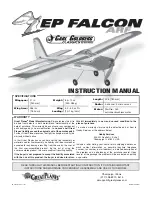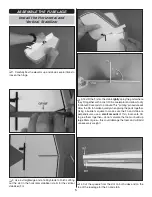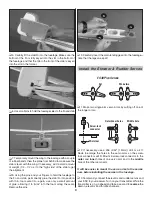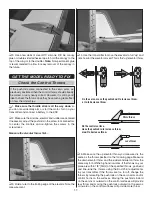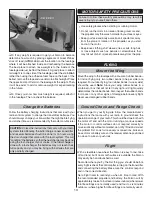
12
These are the recommended control surface throws:
ELEVATOR
HIGH RATE
LOW RATE
3/4"
[19mm]
28°
Up
5/8"
[16mm]
23°
Down
1/2"
[13mm]
13°
Up
3/8"
[10mm]
14°
Down
RUDDER
1-1/2"
[38mm]
35°
Right
1-1/2"
[38mm]
35°
Left
1"
[25mm]
23°
Right
1"
[25mm]
23°
Left
AILERONS
1/2"
[13mm]
24°
Up
3/8"
[10mm]
17°
Down
3/8"
[10mm]
17°
Up
1/4"
[6mm]
12°
Down
Balance the Propeller
Take a few minutes to balance your propeller and a spare
propeller before you fl y. A balanced propeller will help the
motor run smoothly and effi ciently. A severely unbalanced
propeller can cause enough vibration to stress glue joints
and cause screws to loosen.
If the propeller is unbalanced, use a single-edge razor blade
or a hobby knife to scrape material off the heavy blade until
you can get the propeller to balance.
Balance the Model (C.G.)
More than any other factor, the C.G. (center of gravity/balance
point) can have the greatest effect on how a model fl ies. If
you value your model and wish to enjoy it for many fl ights,
DO NOT OVERLOOK THIS IMPORTANT PROCEDURE.
A model that is not properly balanced may be unstable and
possibly unfl yable.
At this stage the model should be in ready-to-fl y condition
with all of the systems in place including the motor, complete
radio system, ESC, propeller and
battery
.
❏
1. With the wings held to the fuselage with a couple of rubber
bands, lift the model by your fi ngers placed on the middle
lines on the bottom of the wing marking the recommended
starting balance point.
❏
2. This is where your Falcon should balance for the fi rst
fl ights. Later, you may experiment by shifting the C.G. 3/8"
[10mm] forward or 3/8" [10mm] back to change the fl ying
characteristics. Moving the C.G. forward will improve the
smoothness and stability and allow the Falcon to perform
tighter turns, but the model will fl y slightly faster. A slightly
more-forward C.G. is also usually desirable for fl ying outdoors
where higher throttle settings are normally used. Moving
the C.G. aft allows the Falcon to fl y more slowly, but will
require slightly more pilot control in tightly-banked turns. A
slightly more-aft C.G. is usually desirable for indoor fl ying
for slower speed. In any case, start at the recommended
balance point and do not at any time balance the model
outside the specifi ed range.
If the model is balanced properly it should rest level when
viewed from the side. If the tail is down the model is “tail-heavy”
and nose weight will be required. If the nose drops the model
is “nose-heavy” and tail weight will be required. (It is typical to
require approximately 1/4 oz. [7g] of nose ballast to achieve
a good starting C.G.)
Содержание EP FALCON ARF
Страница 16: ......

